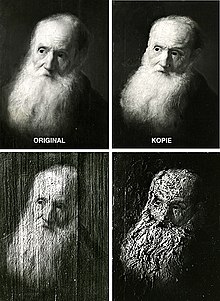Grazing light examination

The grazing light examination is a special form of painting examination . The examiner lets bundled rays of light fall at a flat angle onto the surface of the painting or brush across it in an almost parallel manner. Depending on the angle of incidence, one speaks of a light to sharp grazing light .
When examining grazing light, the height relief of the image surface emerges more clearly through the formation of strong shadows, thus allowing conclusions to be drawn which will be explained later.
development
The process of examining paintings in the sidelight was developed in the 1920s by Fernando Perez, an art-loving physician. As Argentina's ambassador in Rome, he also devoted himself to studying painting technology by testing scientific methods of medicine for examining paintings .
The first extensive sidelight study published, based on the results of Perez, in 1933 Marie-Louise de Gironde. Using the example of some Venetian paintings from the 16th century, she demonstrates the importance of this form of investigation for art history. Under Madeleine Hours , the entire range of possibilities is then worked out and published in the Louvre laboratory in Paris.
Basically this method is as old as the painting examination. Until the invention or the systematic use of X-rays and later infrared rays for examining the surface of a painting, grazing light examination offered the only way to detect changes in shape in painting ( pentimenti ) and overpainted paintings without having to intervene in the picture. Under favorable conditions, style-critical examinations, examinations of the painting technique and restoration-conservational examinations can still be carried out with the grazing light .
literature
- Knut Nicolaus: paintings. Explore-Discover-Explore. Klinkhardt & Biermann, Braunschweig 1982